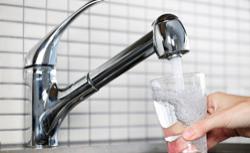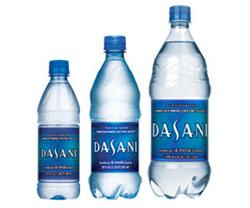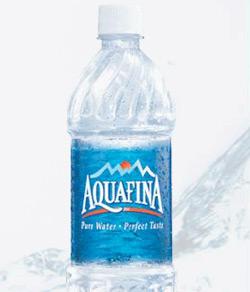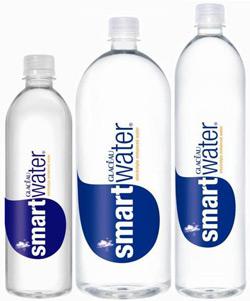If you were born before the year 1990, you may remember the days when bottled water meant a choice between Evian (on the tennis court), Perrier (as an aperitif), and Hinckley and Schmidt (in a paper cup at your doctor’s office). You may remember that when you went for bike rides you inserted into your water holder not a bottle of fresh mineral spring water, but unfiltered tap water held in a mildly carcinogenic plastic squeeze bottle. You may even remember the advent of Clearly Canadian, a drink that rolled around in 1988, and tried, far ahead of the curve, to make drinking water not just a practical necessity, but a sugary party in your mouth.
These days, the experience of shopping for bottled water is akin to the experience of shopping for luxury denim in the mid-aughts, or cupcakes since Sex and the City aired: The market is completely saturated, prices are inflated, and it’s pretty hard to determine where the value is. A quick search for bottled water on Amazon.com reveals nearly 200 distinct brands. Would you like your water caffeinated? Or extracted from 3,000 feet under the sea? How about infused with anti-aging chemicals? No problem!
Even when it comes to the most basic of unflavored bottled waters, the range of options can be confusing. Everyone has an opinion about which brand represents that platonic ideal of water-drinking and which brands fall short. But how deep does brand loyalty go when you have no idea what you’re drinking? We decided to put 11 Slate staffers to the test—to a blind taste test, specifically—to determine if anyone can really taste the difference.
Our methodology was simple: Out of the 11 water brands with the highest market share in the basic, un-enhanced category (based on a Beverage Digest report from May 26, 2011), we chose the four whose names were best known: Aquafina, Poland Spring, Dasani, and Evian. From the enhanced/flavor water category, we chose the unflavored brand with the highest market share: Smartwater. And then we pitted all five against unfiltered New York City tap water. We served these six waters to our colleagues in plain Solo cups, with no indication of which brand was which. We asked each guinea pig to list his or her favorite and least favorite bottled water brands; to rate each anonymous sample on the basis of deliciousness on a scale of one to five; to describe the water’s taste; and to guess which water it might be.
The results, from dirty dishwater to purest elixir of life, are below.

© Evian.
Evian
Average deliciousness rating: 1.45/5
1 liter for $1.99 from D’Agostino
Unless you are referring to the liquid that pools at the bottom of a bong, dank is not a desirable descriptor of water. But that’s how one Slate staffer referred to the well-heeled grandfather of all bottled waters. Evian, which hails from the town of Evian-les-Bains in the French Alps, has been sold in the United States since 1978. In the ‘80s and ’90s, Evian made a name for itself as the sportier—yet still swanky—alternative to carbonated waters like Perrier and San Pellegrino. Though, according to a 1989 article in Ad Age, Michael Jackson and David Lee Roth were both Evian devotees, our panel of taste-testers was not similarly taken by this water’s charms. They described Evian as “salty,” “chalky,” and “soft,” and compared it to water-fountain water, rain-ditch water, pool water, and, my personal favorite: the water “wrung out from sweaty socks.” Of the 11 tasters, eight thought this was the worst water of the bunch. And of the 11, three were able to correctly identify this sample as Evian—meaning that Evian’s taste, if not delicious, is certainly distinctive.

Photograph by iStockphoto/Thinkstock.
Tap Water
Average deliciousness rating: 2.05/5
1 liter for approximately $.002 (according to 2009 estimates)
In my early days of living in New York, I had a roommate who liked to wax poetic on the wonderful quality of New York City drinking water. (When I met his father, who also liked to wax poetic on the wonderful quality of New York City drinking water, I saw where he got it from). They had a point; New York city water is considered exceptionally good—so good, in fact, that one enterprising young man named Craig Zucker recently decided to start bottling and selling it as an alternative to spring water, under the name Tap’d NY. Slate taste testers, ever contrarian, did not agree with my friend and his father. These intrepid folks described the tap water sample as “chlorinic and bleachy,” “slimy,” “sour,” “briny,” and “tongue coating.” One taster even commented that it had a “bad sewer aftertaste.” When asked which water they thought this might be, nobody guessed tap. Three people mistook the sample for Dasani, and one person guessed that it might actually be cleaning water from a bucket.

© Dasani.
Dasani
Average deliciousness rating: 2.95/5
1 liter for $1.79 at D’Agostino
Though Tap’d NY founder Zucker may have gotten some positive press for his innovative idea, he was actually just following in the footsteps of several major American beverage brands. Coca-Cola’s contribution to the bottled water market is Dasani, which calls itself “purified water,” and which is, in fact, tap water, filtered through reverse osmosis, and then fortified with various minerals (Coca-Cola offers a more thorough explanation of the process here). The minerals that are added back in—magnesium sulfate, potassium chloride, and salt—are what give Dasani its unique flavor, a flavor that Dasani brass described as distinctively “crisp” back in 2006. Slate’s tasters did not pick up on Dasani’s signature crispness, or if they did, they found more creative ways to describe it: “slightly spicy,” “somewhat metallic,” and “mineral-y” were popular comments. Several of our tasters, in fact, noted Dasani’s lack of taste, instead describing it as “rinse-y” or “good at cleaning mouth.” Nobody was able to identify this sample as Dasani, and though it was one person’s favorite sample, it was nobody’s least favorite. The takeaway? Dasani is either completely generic, or it simply tastes the way people think water tastes.

© Aquafina.
Aquafina
Average deliciousness rating: 3.1/5
1 liter for $1.87 from CVS
Like Dasani, Aquafina, which is owned by Pepsi Co., bottles municipal tap water that has been treated through reverse osmosis (here’s Pepsi’s diagram of its water purification process). Unlike Coke, however, Pepsi does not pump minerals back into its purified product. Despite Dasani’s wager on the American predilection for crispness, Aquafina actually had the higher market share as of May 2011. (It also, as the New York Times pointed out in 2007, was the choice of the candidate who won the last Democratic presidential nomination; the losing candidate drank Dasani.) So what did our testers make of Aquafina? Although Aquafina scored higher than Dasani, it was actually the more polarizing choice; three people ranked Aquafina highest on their list, and one person ranked it lowest. Much like Dasani, nobody was able to identify Aquafina. Slate tasters repeatedly described this water as “soft,” “metallic,” and a bit “muddy.”One person declared it “the most neutral of the waters.” And one whimsical colleague thought it tasted “vaguely floral.”

© Poland Spring.
Poland Spring
Average deliciousness rating: 3.95/5
1 liter for $0.99 at D’Agostino
Nestlé has distinguished itself by bottling actual spring water from springs across the country and selling that water under regionally specific names (Zephyrhills for Florida, Ice Mountain for the Midwest, etc.). Still, Nestlé’s best-selling spring water is Poland Spring, which is from Maine. Poland Spring bottled water has been around since 1845 (it won the medal of excellence at the Chicago World Fair in 1893), though the brand was bought by Perrier in 1980 and was then absorbed into Nestlé in 1987. These days, Poland Spring water doesn’t actually all come from Poland Spring itself (if you believe a 2003 class-action lawsuit against Nestlé, that spring hasn’t actually flowed since 1967) but, as the brand’s website puts it, from several spring water sources in Maine, each with “a taste and mineral composition similar to our original spring.” Slate tasters remarked on Poland Spring’s high minerality, its slight saltiness, its heaviness on the tongue, and its overall clean taste. Only one person objected to this water, finding it “dirty,” “saltier,” “slightly sour,” and “disconcertingly milky.” Even so, Poland Spring did not qualify as anyone’s lowest rank pick, and it was the favorite of four tasters.
Smartwater
Average deliciousness rating: 4.0/5
1 liter for $2.19 at Kings Pharmacy

© Smartwater.
Over the course of the ‘90s, drinking bottled water went from niche practice to mainstream habit (sales of the stuff went from $115 million to $4 billion between 1990 and 1997). In the early aughts, bottled water gave birth to a whole new subcategory: enhanced bottled water. Enhanced bottled water is water infused with something else: flavor, color, vitamins, herbs, or even caffeine. Though the health benefits of enhanced water have been the subject of great debate, Smartwater, one of the first enhanced waters on the market, has been a success. Jennifer Aniston became an investor and eventually the face of the brand—and in 2007, the company that invented Smartwater was sold to Coca-Cola for $4.1 billion.
So what exactly is Smartwater? It’s distilled, purified water, extracted mostly from municipal water sources, which, once purified, is re-infused with the electrolytes calcium chloride, magnesium chloride, and potassium bicarbonate. According to Slate taste testers, this mix of electrolytes gave smartwater a nice balance of saltiness and sweetness, and a clean, light, and pure taste. Two tasters made reference to a tannic undertone. An unprecedented five tasters ranked this enhanced water as their favorite, and none ranked it as least favorite. One taster summed up the collective opinion, by calling Smartwater—appropriately, the most expensive of all the options—“the champagne of waters.”
